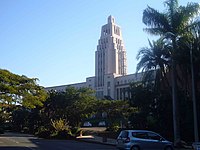University of Natal
This article needs additional citations for verification. (November 2007) |
KwaZulu Natal , | |
| Current status | On 1 January 2004 the University of Natal as a distinct legal entity ceased to exist.[2] It was incorporated on the above date into a new legal entity which is called the University of KwaZulu-Natal.[2] The University of Natal was regulated by the University of Natal Act 7 of 1960. |
|---|---|
| Colours | Black, blue, green |
| Website | nu.ac.za |
The University of Natal was a university in the former
On 1 January 2004, the University of Natal was merged with the University of Durban-Westville to create a new legal entity called the University of KwaZulu-Natal, as part of a broader reorganisation of South African universities.[2]
Former University Presidents
The Council of the University of Natal voted on 31 May 2002 to offer the post of Vice-Chancellor and University Principal to world-renowned medical scientist and former Medical Research Council President - Professor Malegapuru Makgoba who assumed office on the 1 September 2002. He was entrusted with leading the University of Natal into the merger with the University of Durban-Westville. In so doing, he became the last Vice-Chancellor of the University of Natal. Professor Makgoba succeeded Professor Brenda Gourley as Vice-Chancellor.
Brenda Gourley, a qualified chartered accountant, was the second last vice-chancellor of the University of Natal. Her appointment at the university in 1994 was an historical event in South Africa. She was the first woman in South Africa to be appointed as a vice-chancellor of a South African university.
The Maritime law programme based at the then Institute of Maritime Law at the University of Natal, which was pioneered under the headship of Professor Hilton Staniland, was one of the first Maritime law programmes of its kind in South Africa. The above institute was well known in South African Maritime circles. A number of South African statutes regulating the South African maritime industry were drafted by Professor Hilton Staniland at the above Institute, including the Carriage of Goods by Sea Act 1 of 1986 and the Wreck and Salvage Act 94 of 1996.[3]

Events
Under apartheid, the Howard College Campus, in Durban, was known for the activism of its staff and students against government-imposed racial segregation. Particularly in the 1960s Natal University students were active in the non-racial National Union of South African Students, which was one of the main organizations opposing the apartheid system. In the 1970s and 1980s many of its students were members of the often-banned South African Students' Organisation (SASO), centred on the main arts centre at the Howard College campus. In addition, the university magazine Dome (named for the dome of the Howard College Building), was active against apartheid and was often banned, with the printing press being moved around to prevent its being confiscated by police.
Campus Facilities
The main science block on the Howard College campus, completed in the early 1980s, was a pivotal location for biological research and game conservation for the province. The Howard College campus in Durban was strung out along the Berea, a ridge to the north of the Durban city centre.
The Howard College campus had a number of onsite residences, named after prominent South Africans including
The Pietermartizburg campus was the original campus, though it later became the smaller of the two main campuses. The campus is in a suburban location, centred on the library and administration buildings. The library houses many historic books, including books on colonial history and
The Pietermaritzburg campus houses the Alan Paton Centre & Struggle Archives.[4][5] Formerly called the Alan Paton Centre for the Study of the Literature and Politics of Inter-group Conciliation, this centre was opened on 24 April 1989 by Professor Colin Webb.[6][7][8]
Alumni
References
- ^ a b Guest, Bill (2009). "Stella Aurorae: Establishing KwaZulu-Natal's First University" (PDF). Natalia (39). Natal Society Foundation: 65–78. Retrieved 12 October 2012.
- ^ a b c d "Statute of the University of KwaZulu-Natal (Proclamation number R.684, 2006)" (pdf), Government Gazette, vol. 29032, no. 3, 14 July 2006, retrieved 31 August 2014
- ^ "Professor Hilton Staniland". Institute of Maritime Law. University of Southampton. Retrieved 31 August 2014.
- ^ "HOW BELOVED IS ALAN PATON'S BELOVED COUNTRY? A HISTORICAL APPRAISAL by MORGAINNE SUE DU PLESSIS" (PDF).
- ^ "About us • Alan Paton Centre".
- ^ "Concord - Newsletter March 1997".
- ^ "Colin de Berri Webb (1930-1992)" (PDF).
- ^ "Theoria May 1992" (PDF).
External links
- University of Natal at the Wayback Machine (archive index)
- University of Natal-Durban at the Wayback Machine (archive index)
- University of Natal-Pietermaritzburg at the Wayback Machine (archive index)
